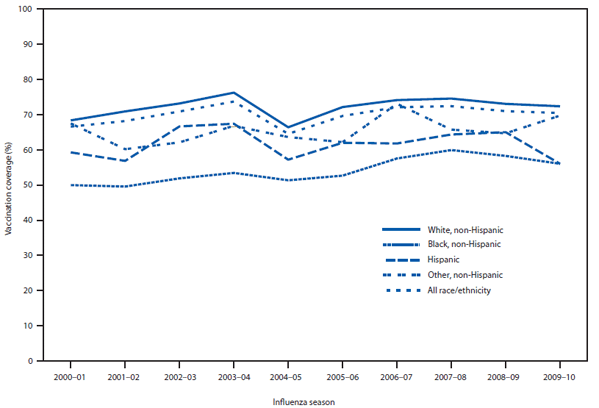* The response rate is the number of complete interviews divided by the number of eligible persons in the sample. The cooperation rate is the proportion of all persons interviewed among all eligible persons ever contacted.
† High-risk conditions include asthma, other lung problems, diabetes, heart disease, kidney problems, anemia, weakened immune system caused by a chronic illness or by medicines taken for a chronic illness.
§ Respondents who self-identified as Asian, American Indian/Alaska Native, Native Hawaiian, Pacific Islander, and persons of multiple races were classified in the "Other" group because of the small sample size.
FIGURE. Influenza vaccination coverage for adults aged ≥65 years, by race/ethnicity ---Behavioral Risk Factor Surveillance System (BRFSS), United States, 2000--2010*

* For the 2000--01 through 2008--09 seasons, BRFSS survey data collected during March--August each year were used to estimate point estimates of coverage for adults aged ≥65 years. For the 2009--10 season time point, Kaplan-Meier survival analysis was used to estimate coverage among adults aged ≥65 years by using BRFSS and National 2009 H1N1 Flu Survey data collected during October 2009 -- June 2010. The 2009--10 time point estimates do not include influenza A (H1N1) 2009 monovalent vaccinations.
Alternate Text: This figure depicts the percentage of persons vaccinated against influenza viruses during 2000-2010, by race/ethnicity. For the 2000-01 through 2008-09 seasons, BRFSS survey data collected during March-August each year were used to estimate point estimates of coverage for adults aged ≥65 years. For the 2009-10 season time point, Kaplan-Meier survival analysis was used to estimate coverage among adults ≥65 years by using BRFSS and National H1N1 Flu Survey data collected during October 2009-June 2010. The 2009-10 time point estimates do not include influenza A (H1N1) 2009 monovalent vaccinations.
Use of trade names and commercial sources is for identification only and does not imply endorsement by the U.S. Department of
Health and Human Services.
References to non-CDC sites on the Internet are
provided as a service to MMWR readers and do not constitute or imply
endorsement of these organizations or their programs by CDC or the U.S.
Department of Health and Human Services. CDC is not responsible for the content
of pages found at these sites. URL addresses listed in MMWR were current as of
the date of publication.
All MMWR HTML versions of articles are electronic conversions from typeset documents.
This conversion might result in character translation or format errors in the HTML version.
Users are referred to the electronic PDF version (http://www.cdc.gov/mmwr)
and/or the original MMWR paper copy for printable versions of official text, figures, and tables.
An original paper copy of this issue can be obtained from the Superintendent of Documents, U.S.
Government Printing Office (GPO), Washington, DC 20402-9371;
telephone: (202) 512-1800. Contact GPO for current prices.
**Questions or messages regarding errors in formatting should be addressed to
mmwrq@cdc.gov.
 ShareCompartir
ShareCompartir


